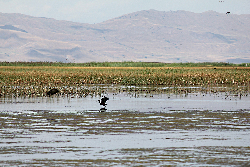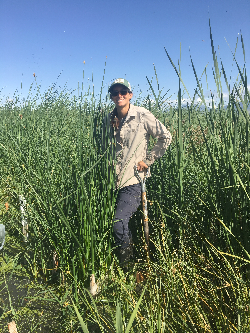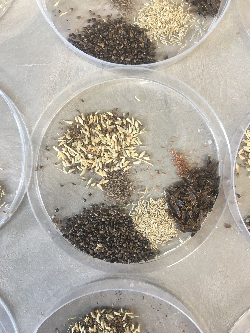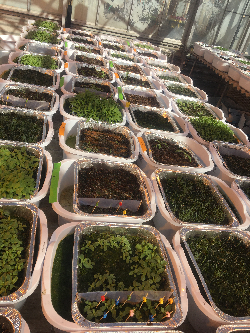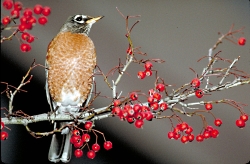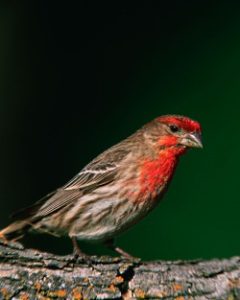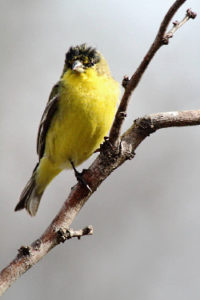
Achnatherum hymenoides
Courtesy Wikimedia
& US NRCS
A few ornamental grasses that you might consider planting in your landscape are Indian rice grass, blue grama grass, little bluestem, Indiangrass, and Miscanthus.
One of the most attractive native grasses, and the state grass of Utah, is Indian rice grass. This native, cool-season grass grows from 1 to 2 ½ feet tall. Widely adapted in Utah, it is important in foothill and semi-desert areas of the state, providing forage for both livestock and wildlife throughout the year. It has a lovely, airy texture and the seeds are an important food source for many birds and small mammals.
Blue grama grass, also native to Utah, is a warm-season grass with seed stalks standing 6 to 20 inches tall. In the wild areas of Utah, blue grama grass grows on plains, foothills and woodlands and tolerates a variety of soil conditions. In home landscapes, the distinctive seed heads of blue grama are very attractive and are sometimes described as resembling eyebrows.
Little bluestem, a warm-season perennial grass, grows from 1 to 2 feet tall. This drought-tolerant, native grass grows in many Utah plant communities including desert shrub, ponderosa pine, and pinyon-juniper. In ornamental landscapes, little bluestem transitions from blue/green colored grass blades during the growing season to a reddish color after the first frost, providing lots of winter interest in the landscape as well as food and cover for birds.
Indiangrass is a native, warm-season perennial grass with tufted stems reaching up to 5 feet tall. This grass is found in the hanging garden plant communities of southern Utah where annual rainfall is low but flooding from runoff water is common. It may also be associated with other riparian plants such as sedges, rushes, and willows. A tall, upright grass, Indiangrass has showy, golden bronze seed heads in the fall that provide seed for songbirds.
Though not native to Utah, Miscanthus is another ornamental grass that provides food for birds. This large grass, growing up to 6 feet tall, has flower plumes above the foliage in the fall and you may see birds searching the ground underneath throughout the winter looking for leftover seeds.
Hopefully you have one or more of these grasses in your landscape already, but if not, fall is still a good time to plant them. And don’t cut these grasses back as we head into the colder months of the year. They provide a great deal of color and interest to the winter landscape and will continue to provide food and cover for birds and wildlife throughout the season.
As our weather warms into spring, birds will be particularly focused on the dried-out grass blades that remain, using coarse blades for the main wall of nests and finer blades as part of the softer, inner lining.
So, go ahead and try some ornamental grasses in your home landscape or maybe plant more. You’ll be well on your way to attracting and supporting birds and other wildlife.
I’m Kelly Kopp with USU Extension’s Center for Water Efficient Landscaping and I’m Wild About Utah.
Credits:
Images: Courtesy & Copyright , Photographer
Audio: Courtesy & © Kevin Colver https://wildstore.wildsanctuary.com/
Text: Kelly Kopp, PhD, Plants, Soils & Climate, Utah State University https://psc.usu.edu/directory/faculty/kopp-kelly
Additional Reading Links: Lyle Bingham
Additional Reading:
Lady Bird Johnson Wildflower Center:
Indian ricegrass, Plant Database, Lady Bird Johnson Wildflower Center, https://www.wildflower.org/plants/result.php?id_plant=achy
Blue Gamma, Plant Database, Lady Bird Johnson Wildflower Center, https://www.wildflower.org/plants/result.php?id_plant=bogr2
Little bluestem, Plant Database, Lady Bird Johnson Wildflower Center, https://www.wildflower.org/plants/result.php?id_plant=SCSC
Indiangrass, Plant Database, Lady Bird Johnson Wildflower Center, https://www.wildflower.org/plants/result.php?id_plant=sonu2
Missouri Botanical Garden
Miscanthus, Missouri Botanical Garden, https://www.missouribotanicalgarden.org/PlantFinder/PlantFinderDetails.aspx?taxonid=250962&isprofile=1&basic=miscanthus
Miscanthus, Plant Finder, Missouri Botanical Garden, https://www.missouribotanicalgarden.org/PlantFinder/PlantFinderProfileResults.aspx?basic=miscanthus
Morton Arboretum
https://www.mortonarb.org/trees-plants/tree-plant-descriptions/chinese-silver-grass
Miscanthus sinensis, The Morton Arboretum, https://www.mortonarb.org/trees-plants/tree-plant-descriptions/chinese-silver-grass
USU Extension Range Plants of Utah
Indiangrass, Range Plants of Utah, Utah State University Extension, 2017, Indiangrass
Little bluestem, Range Plants of Utah, Utah State University Extension, 2017, https://extension.usu.edu/rangeplants/grasses-and-grasslikes/little-bluestem
Indian ricegrass, Range Plants of Utah, Utah State University Extension, 2017, https://extension.usu.edu/rangeplants/grasses-and-grasslikes/indian-ricegrass
Blue grama, Range Plants of Utah, Utah State University Extension, 2017, https://extension.usu.edu/rangeplants/grasses-and-grasslikes/blue-grama
Sagers, Larry, Ornamental Grasses, Utah Cooperative Extension Service, https://digitalcommons.usu.edu/cgi/viewcontent.cgi?article=2342&context=extension_histall
Roger Banner, Roger, Pratt, Mindy, Browns, James, Grasses and Grasslike Plants of Utah, A Field Guide,, Extension, Utah State University and Utah Partners for
Conservation and Development, 2011 (2nd ed), https://digitalcommons.usu.edu/cgi/viewcontent.cgi?article=2188&context=extension_curall
Wheaton, Adrea, Rupp, Larry & Caron, Michael, 10 Low-Water Ornamental Grasses, Ideal for Water-Efficient Landscapes in Eagle Mountain, Utah, Extension, Utah State University, , https://digitalcommons.usu.edu/cgi/viewcontent.cgi?article=2875&context=extension_curall
Gunnell, JayDee, Goodspeed, Jerry L., Anderson, Richard M., Ornamental Grasses in the Landscape, Extension, Utah State University, June 2015, https://digitalcommons.usu.edu/cgi/viewcontent.cgi?article=1739&context=extension_curall




